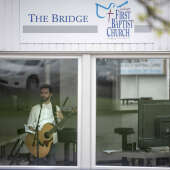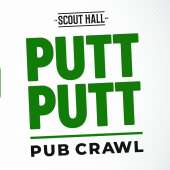
Live! at the Ozark Opry book cover (Submitted photo)
ABOUT DAN WILLIAM PEEK
Age: 65
Hometown: Versailles, Mo.
City of residence: Columbia, Mo.
Family: Wife, Joy Lynn Peek; blended family with two daughters, three sons, two daughters-in-law and two grandchildren

Dan William Peek (Photo by David Owens)
Other work: I am president and co-founder of Grandparents and Others on Watch Inc., a 501(c)3 organization that seeks to educate society about sexual predators who target children.
Favorite activities: Playing five-string banjo, learning new things and reading, fishing and hanging out with family, especially the grandchildren.
How did you first become interested in the Ozark Opry, and why is it still special to you?
In 1962, when I was a junior in high school in Versailles, Mo., two schoolmates, Ken Peoples and Jerome Wheeler, and I formed a musical group patterned on the popular folk singers the Kingston Trio. Because Ken could play guitar and Jerome the mandolin, I was assigned the task of learning to play banjo. I purchased a banjo -- an old open-back flailing banjo -- for $5, rescued from the attic of someone in town, and set about learning the instrument. This casual foray into music would lead me to meet and spend a fair amount of time with Lee Mace between the fall of 1963 and the fall of 1964 -- my 18th year on the planet.
Lee hired the three of us, the New Morning Singers, to perform in "Lee Mace's Hillbilly Hootenanny." He sent us home from the audition with instructions to make a microphone and stand from a broom handle, a wooden Christmas tree stand and a Cracker Jack box. We were to practice moving in and out of the microphone as we played and sang. This was our introduction to professional entertainment. There would be much more tutoring to come. We appeared numerous times on the Ozark Opry television show, and Lee booked several performances for us at fairs and events that year.
The Ozark Opry is a special memory to millions of people and was much more important in the development of the modern country music industry than has been hitherto recognized. That special personal connection that so many people feel with Lee Mace's Ozark Opry and the important place it holds in country music history are two principal reasons that I wrote "Live! At the Ozark Opry."
Tell us some more about your music and your relationship with Lee Mace.
Anyone who spent any time with Lee Mace was unlikely to forget him, and I'm no exception. I never saw him again after 1964 -- he died in a plane crash in 1985 -- but I knew I should write about him and his wife, Joyce, who continued to run the Ozark Opry for 20 years after his death. A remarkable person in her own right. Lee was a unique person. When I met him he was in his mid-30s and a very successful country music artist and entrepreneur. But he always took time to look after and talk with the young people who played music in his shows. Most people have some sense of obligation for the feelings and cares of others, something like moral responsibility. But Lee seemed to be more certain in that responsibility, more sure of how to mentor and nurture, and more willing to do so than most. At the same time he drove a hard bargain in business and had a clear vision of what he wanted to accomplish with the Ozark Opry.
As to my musical background, I still play a little banjo (actually it is a regular size J.D. Crowe model Mastertone). After the season with Lee, one of the other New Morning Singers, Jerome Wheeler, and I ventured into folk and folk-rock for about a dozen years. We called the group the Celebrated Renaissance Band and toured widely. One of our tunes made Billboard's Hot 100 in 1969. It was reissued in 2000 on a compilation CD titled "Buzz, Buzz Buzzzzz, Vol. 1," which is still on the market. The band broke up in the mid-1970s. I moved to the east coast and evolved into a marketing consultant and writer. We've had music at the book signings so far, most places we've been there are Ozark Opry alumni and we try to get them out to play. There are several right there around Cape Girardeau and in Southern Illinois. We'll invite them out when the book tour comes to the area.
Could you give us a brief overview of the book?
The Ozark Opry operated continuously from 1953 to 2005. Joyce Mace told me the show would still be running had the state not taken much of the parking lot to expand Highway 54 in Osage Beach. I should mention that Joyce was very generous with her time and with the access to the photographs and documents that provided much of the source material for "Live! At the Ozark Opry." And she wrote a great foreword for the book. Most reports on the Ozark Opry commence with the first stage shows, in the basement of the Casino Restaurant at the west end of Bagnell Dam in 1953. But the history of the show and Lee and Joyce goes back several years before that date, when the couple and some friends formed the Lake of the Ozarks Square Dancers and ultimately performed their "Ozark jig" at the National Folk Festival in St. Louis in 1948. The troupe toured nationally, performed on "Ted Mack's Amateur Hour" and Dave Garroway's "Today"show, among other successes. In 1953 the group was hired by the Grand Ole Opry to be the Grand Ole Opry Square Dancers Between 1954 and 1956, Lee and Joyce and their jig-dancing friends were prominently featured in about 100 shows hosted by Ernest Tubb and other Nashville stars and produced for WSM television by Albert Gannaway. But the Maces did not settle in Nashville; they had something else in mind, something that would transform the country music industry. They founded the Ozark Opry, the first show in the nation to run, in season, six nights a week (some nights with two shows), with the same cast of performers and the same song repertoire all season long. The Ozark Opry format became an alternative dimension in country music, a part of the country music industry that is now generally referred to as Branson-style entertainment. How Lee and Joyce accomplished this end is a spellbinding tale of talent, intellect and will. Interwoven in the narrative are profiles of famous Nashville stars, business figures and entrepreneurs who interacted with the Maces along the way, as well as profiles of some of the musicians who helped create the Ozark Opry stage show. There are 48 photographs and images of historic and cultural interest and importance in "Live! At the Ozark Opry."
What else should we know about you?
Well, I'm also the author of a social history of the sport of darts, "To The Point: The Story of Darts in America." It's been out for a while but is still in print and available at amazon.com and other sites. I'm working on another book that I should have completed in about a year, so be sure to check every so often to keep your collection of books authored by Dan William Peek current. I am looking forward to coming to the Cape area soon and doing some book events. I hope everyone with a memory of the Ozark Opry will come out and share the time with me and whomever of the Ozark Opry gang come out to play.
Peek's new book is available at www.amazon.com and from the publisher, The History Press, at www.historypress.net.
 Local News 4/19/24Inside Becca’s Closet: A mission to dress teens for formal eventsThe organization Becca’s Closet, which helps young girls get access to formal dresses for dances and proms, is celebrating its 20th anniversary this year. Cape Girardeau is the home to one of two Missouri chapters, and one of 51 in the U.S...
Local News 4/19/24Inside Becca’s Closet: A mission to dress teens for formal eventsThe organization Becca’s Closet, which helps young girls get access to formal dresses for dances and proms, is celebrating its 20th anniversary this year. Cape Girardeau is the home to one of two Missouri chapters, and one of 51 in the U.S... Local News 4/19/24Southeast Missouri State University's symphony conductor Sara Edgerton to retire2Sara Edgerton, professor of cello and string bass and artistic director and conductor of the Southeast Missouri Symphony Orchestra at Southeast Missouri State University, is set to retire after 33 years...
Local News 4/19/24Southeast Missouri State University's symphony conductor Sara Edgerton to retire2Sara Edgerton, professor of cello and string bass and artistic director and conductor of the Southeast Missouri Symphony Orchestra at Southeast Missouri State University, is set to retire after 33 years...






 Local News 4/18/24Catholic Charities to hold ribbon-cutting for LifeHouse grand openingLifeHouse Crisis Maternity Home will provide education and support to pregnant women and new mothers at risk of homelessness. After 15 months of construction, the first resident will move in at the end of April. ...
Local News 4/18/24Catholic Charities to hold ribbon-cutting for LifeHouse grand openingLifeHouse Crisis Maternity Home will provide education and support to pregnant women and new mothers at risk of homelessness. After 15 months of construction, the first resident will move in at the end of April. ... Local News 4/18/24Tenmile looks to add balcony to old Esquire Theater building2Cape Girardeau City Council approved a license and indemnity agreement with Tenmile Holdings LLC on Monday, April 15, for the installation of a marquee sign and awning with column posts for the old Esquire Theater building. ...
Local News 4/18/24Tenmile looks to add balcony to old Esquire Theater building2Cape Girardeau City Council approved a license and indemnity agreement with Tenmile Holdings LLC on Monday, April 15, for the installation of a marquee sign and awning with column posts for the old Esquire Theater building. ... Local News 4/18/24SEMO Orchestra to perform Elgar, Dvorak next week at River CampusThe Southeast Missouri State University Orchestra and guest cellist Julian Schwarz will present a two-piece program Tuesday, April 23, at the River Campus in Cape Girardeau. The concert will begin at 7:30 p.m. in Bedell Performance Hall, 518 S....
Local News 4/18/24SEMO Orchestra to perform Elgar, Dvorak next week at River CampusThe Southeast Missouri State University Orchestra and guest cellist Julian Schwarz will present a two-piece program Tuesday, April 23, at the River Campus in Cape Girardeau. The concert will begin at 7:30 p.m. in Bedell Performance Hall, 518 S.... Local News 4/18/24Police: Bollinger County woman told elaborate lies across multiple investigations, including sexual assault4BOLLINGER COUNTY — Police say a Bollinger County woman told several elaborate lies during sexual assault and harassment investigations in a complex and escalating scheme that targeted the mother of her fiance’s child. Michelle D. Kaempfer of Glen...
Local News 4/18/24Police: Bollinger County woman told elaborate lies across multiple investigations, including sexual assault4BOLLINGER COUNTY — Police say a Bollinger County woman told several elaborate lies during sexual assault and harassment investigations in a complex and escalating scheme that targeted the mother of her fiance’s child. Michelle D. Kaempfer of Glen... Local News 4/18/24Jackson police, DEA host National Prescription Drug Take Back Day1The Jackson Police Department and Drug Enforcement Administration (DEA) will team up to host DEA’s National Prescription Drug Take Back Day on Saturday, April 27. The two organizations will collect different forms of prescription drugs. The...
Local News 4/18/24Jackson police, DEA host National Prescription Drug Take Back Day1The Jackson Police Department and Drug Enforcement Administration (DEA) will team up to host DEA’s National Prescription Drug Take Back Day on Saturday, April 27. The two organizations will collect different forms of prescription drugs. The...










 Most read 4/15/24Cape airport explores funding for possible new air traffic control tower12As Cape Girardeau Regional Airport’s construction projects move along, airport manager Katrina Amos and the Airport Advisory Board may start to look at possible funding options for a new air traffic control tower. Amos said the next big project on...
Most read 4/15/24Cape airport explores funding for possible new air traffic control tower12As Cape Girardeau Regional Airport’s construction projects move along, airport manager Katrina Amos and the Airport Advisory Board may start to look at possible funding options for a new air traffic control tower. Amos said the next big project on...


 Most read 4/12/24Notre Dame to transition to president/principal model beginning July 17Notre Dame Regional High School announced Monday, April 8, that it will be transitioning to a president/principal model Monday, July 1. Current principal Tim Garner will assume the role of president, while assistant principal Paul Unterreiner will...
Most read 4/12/24Notre Dame to transition to president/principal model beginning July 17Notre Dame Regional High School announced Monday, April 8, that it will be transitioning to a president/principal model Monday, July 1. Current principal Tim Garner will assume the role of president, while assistant principal Paul Unterreiner will... Most read 4/12/24Coroner still hasn't found attorney as Missouri AG seeks to remove him from office14More than two months after the Missouri Attorney General's Office filed court action to remove Cape Girardeau County Coroner Wavis Jordan from office, the local officeholder has still not found an attorney to help him fight to keep his job. Wavis...
Most read 4/12/24Coroner still hasn't found attorney as Missouri AG seeks to remove him from office14More than two months after the Missouri Attorney General's Office filed court action to remove Cape Girardeau County Coroner Wavis Jordan from office, the local officeholder has still not found an attorney to help him fight to keep his job. Wavis...

